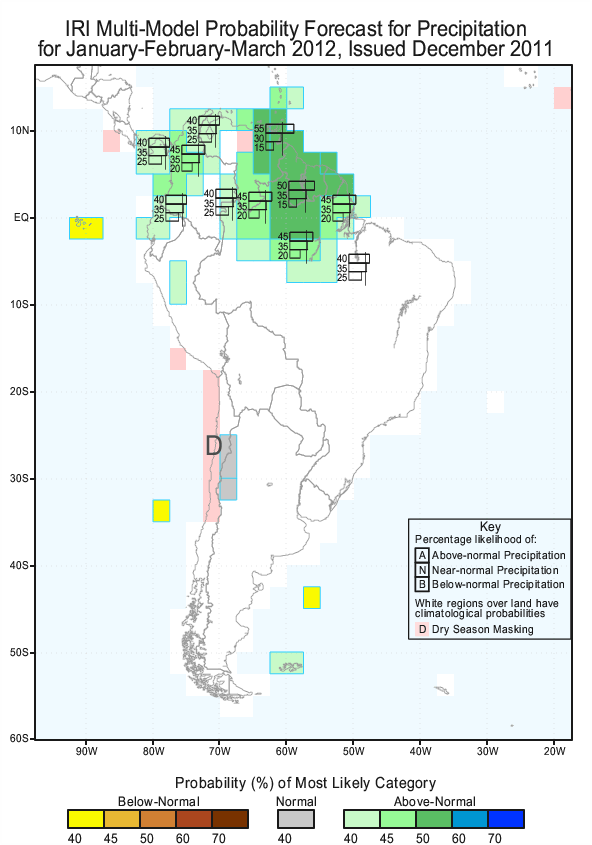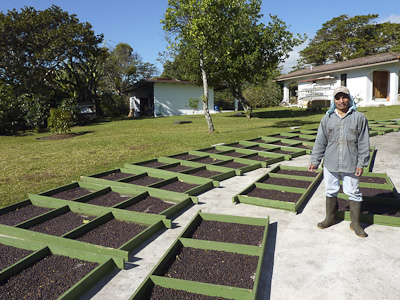| January 4, 2012 | No. 47 |
December 2011
I posted the December weather data for the Palmira Weather Station today. We recorded a total of 1.12 inches of rain in December at the Palmira Station. Terry Zach in El Santuario reports 7.15 inches of rain. Steve Sarner in Jaramillo Arriba reports 5.01 inches. Sela Burkholder in Jaramillo Abajo reports 2.54 inches. Craig Bennett in Los Naranjos reports 3.96 inches. Here is the list from least to most rainfall in the month of December.
Rainfall for December 2011 |
||
| Palmira Arriba | Lloyd Cripe | 1.12 |
| Jaramillo Abajo | Sela Burkholder | 2.54 |
| Los Naranjos | Craig Bennett | 3.96 |
| Jaramillo Arriba | Steve Sarner | 5.01 |
| El Santuario | Terry Zach | 7.15 |
The December rain results are in keeping with expectations. The winds (mainly from the NE) have picked-up during the month of December. The average wind at the Palmira Station in December was 11.5 mph and the maximum recorded wind was 33.0 mph. With the northeast winds, moisture debris is blown over the mountains from the Caribbean side into the District of Boquete. This results in more moisture in the northern part of the district. This is seen in the table above with more rainfall recorded in the Bajareque affected areas.
Steve Sarner up high on Jaramillo has been observing and collecting weather data for many years. He is now contributing monthly rain data and sent me monthly data for the last 2 years. Thanks to Steve for his contribution we will now have another district location to observe.
The annual results are in. The Palmira Station registered 177.01 inches of rain in 2011. A check of the Annual Climate Data tables at the Website indicates that this is less than last year (2010) and a bit below the mean (191.1 inches, range 146.18 to 222.68 inches) for the last 4 years. Below is a table of the rainfall totals for 5 areas in the District of Boquete ordered from most to least.
Total Rainfall for 2011 |
||
| Jaramillo Abajo | Sela Burkholder | 211.97 |
| Jaramillo Arriba | Steve Sarner | 170.32 |
| Palmira Arriba | Lloyd Cripe | 177.01 |
| El Santuario | Terry Zach | 149.41 |
| Los Naranjos | Craig Bennett | 135.20* |
*month of June estimated
You can make what you want with these numbers. I think they basically indicate that different areas in the District of Boquete get different amounts of total rainfall but they all get a lot of rain. 212 inches is 17.7 feet and 135 inches is 11.25 feet. That is a lot of water. Fortunately it drains off rapidly penetrating the soil and flowing down grade. While you may be able to pick areas in the District of Boquete with more or less rain, the rainy season brings plenty of rain to all. We all live in the verdant Tropical Highlands.
The ENSO is now in a La Niña condition. La Niña are present and expected to continue in the Northern Hemisphere during the winter of 2011-2012. Here is the link to the latest La Niña report.
For information from the National Weather Service JetStream - Online School for Weather regarding the Weather Impacts of ENSO visit their web page.
If interested, you can monitor the status of La Niña and get weekly updates at the NOAA Climate Prediction Center at this link.
The IRI (International Research Institute for Climate and Society) is again reporting a 40 percent probability that January 2012 through March 2012 will bring some increased precipitation to our area. Here is their graphic presentation: (Note the light green in our area which predicts a 40 percent probability of some increased precipitation):

Fewer days of rain (only 8 in December) and more days of sunshine and wind are good for drying the newly harvested coffee. After the coffee fruit (cherries) are harvested, the beans inside need to be dried to about 11 percent humidity. It is a big challenge drying coffee in Central America during the weeks of transition form the rainy season to the dry season. There are basically two ways to process the coffee cherries and get the coffee dried. One way is to simply dry the cherries in the sun. This is called the natural method. The other way is to pulp the cherries (take off the fruit/skin) and dry the parchment covered beans in the sun. Drying in the open is weather dependent.
 |
 |
Natural Method |
Pulped or Wet Method |
It takes a lot longer to dry cherries in the sun than to dry them after the skin/fruit is taken off the parchment. Consequently, most coffee processors in Central America don't use the natural drying method. They more commonly use the wet method where the coffee is pulped, washed then dried in its parchment hull. It is dried a few days in the open and then dried in large fueled rotating drying drums which are like giant clothes dryers. The drying is done very quickly this way. On our small coffee farm, we use both methods (natural and pulped) to produce Palmira Gold Coffee but dry all our coffee in the sun. Our favorite cup of coffee is the result of the natural sun dried method. We like this method because we think it delivers richer more interesting flavors than the wet method. With sunny windy days we can dry the pulped coffee in about 7 days. The natural method of drying the entire cherry takes 3 to 4 weeks. It is a lot more work and more dependent upon good weather. We put the cherries undercover at night and bring them out into the sun if it is good sunny weather. The drying cherries can't get wet, so if there is any chance of rain we have to get or keep the cherries under cover. The mixed days of sun and rain during the transition months make this a significant challenge. Fortunately, this December has been a relative good month with fewer challenges due to more cooperative weather. For this we are grateful.
The last couple of days we have been getting some mist (Bajareque) in the afternoon and we have to rush to get the drying cherries under cover before they get wet. This keeps us hopping. I think what we should probably do is by a thousand umbrellas and set them strategically in place. When it starts to drizzle we could quickly open the umbrellas and the drying cherries would be protected. What we currently do is quickly carry the drying beds under our carport and get some sweaty exercise. Come to think of it, I don't know how we would get a thousand umbrellas instantly elevated. I guess my physical fitness program with Miguel will continue as it is.
Lloyd Cripe
